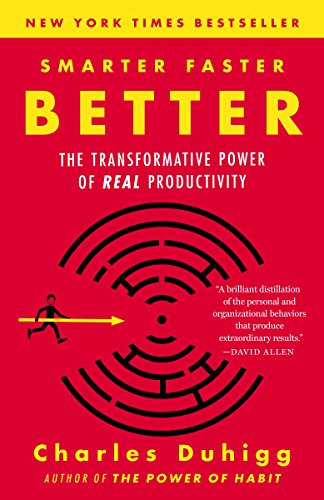If you work for a large corporation, you have countless HR meetings, orientation, training, client introductions, et cetera. As a freelancer, however?
You jump right into the deep end. Here is why it’s an advantage and one of the greatest ways you can quickly gain knowledge.

smarter faster better
by Charles Duhigg
⏱ 14 minutes reading time
🎧 Audio version available
It’s Personalized
Unlike a regular job, where you’re likely to receive written instructions on everything you need to know about your job, freelancers have a very different experience. No matter how good your education is or how much experience you have, again, you’re diving into the deep end. One of the best ways to approach freelancing is learning on the job.
This is not an attempt to scare you away. In fact, by the end of this video, you’ll be more than ready to dive in yourself. The best thing about freelancing is the freedom that comes with it. You’re free to make your own schedule, choose which clients you want to work with, and the kind of work you want to do. All in all, everything about your work is unique.
Learning on the job helps you further tailor your work to your clients. You’re learning everything you need to know– and learning to avoid what isn’t useful, which leads to more, and better, success.
Instead of also being forced to learn a lot of things you’re never going to use, you’ll be able to filter through all the fluff and learn what you can use– instead of wasting your time and effort with skills that aren’t useful to your field.
It’s Cost-Effective
Ah, cost-effective. A term every freelancer, new or old, loves to hear. Here is another great thing about learning on the job– it’s a lot cheaper than any other way.
At a normal job, training can cost literally thousands. HR Onboard estimated that the average cost of bringing a new employee and training them can reach up to and over $40,000. If you specialized in the technology industry, you can easily double that number.
Learning on the job isn’t just a quirky way to approach acquiring skills– it can be a necessity if you don’t have the funds. Because you’re diving into the deep end, working with whatever software, device, document, or material you’re going to be using on a daily basis, you don’t need to pour money into a course. This is why traditional training courses and expensive workshops are being usurped.
It’s More Efficient
On the job learning stands out because instead of spending hours in a crowded and stuffy conference room, trying to focus on a Powerpoint presentation, you’re experimenting and testing how things work for yourself. To say that this approach is more efficient is an understatement.
It saves time in the sense that it’s both practical and intensive. As a new freelancer, you want to make as much progress per day as possible, and as quickly as possible. So it makes sense that taking the time out of the day and removing yourself from your immersive work place to train takes a giant chunk out of your schedule.
You’re learning while you’re working, so– technically– you’re still doing your job, which means you’re making headway. Plus, a hands-on approach is a much better and faster way to establish an efficient routine. Once you’ve done it a few times, you’ll have built some muscle memory and will be able to go through your process faster the next time, already knowing which errors to avoid.
There is also efficiency in the sense that you don’t have to even leave your workstation or desk to take a training course. You’re not even taking time off. Learning on the job means that you get to start working in your chosen job immediately rather than waiting until a course has a spot for you.
Networking
There is another added benefit to this hands-on approach. You’re unlikely to become an expert overnight, and a hands-on approach often requires a mentor or advice from other freelancers in the same field as you.
You’ll meet people and build your network this way.
It Helps Address Your Weaknesses
Did you know that it’s estimated that by 2030, up to 375 million people will need to learn new job skills in order to adapt to the ever-changing technological transformation?
That’s on top of the old adage: how no matter how much education or experience you may have, you always have something new to learn. You can’t spend your life in a classroom; you need to apply your new skills.
There are plenty of debates about the importance of education versus experience. We won’t get into the nitty gritty details today, but the main takeaway is: it’s important to find balance.
Even if you weren’t a freelancer, employers want to know what you have to offer and how you react in real-world job situations. Strictly academia with no experience will only get you far.
Learning on the job helps you fill in the gaps of what your formal education didn’t teach you. This way, you’ll strengthen your skills and make room for further development.
It Helps You Grow Personally
For the same reason some parents leave their kids to learn to swim on their own, learning on the job is one way you can grow personally.
The act of learning on the job brings career readiness and offers an unparalleled sense of purpose. You’re also gaining an incredible sense of achievement because the process of learning is rewarding on its own. You’re gaining independence and learning to move forward in your life. No amount of courses could give you the same ability to think on your feet, to solve problems, and to expand how you think.
It’s More Engaging
A Salesforce research found that on the job learning is a key driver of success, with over 70% of employees saying that this method helped them become more productive and engaged at work.
During training, everyone is guilty of zoning out occasionally. But because you’re learning as you work, training becomes engaging. Forget about the dullness of a classroom.
A lot of companies have built-in processes to help their employees learn while others trust that their new hires will just figure it out. As a freelancer, you don’t get that luxury. However, fear not. Why? It’s because adaptable learners are in high demand.
Proof of that lies in this Satya Nadella quote– Satya Nadella is Microsoft’s current CEO. He’s among those who believe it’s important to be ready to learn in the evolving world. He says, “We want to be not a ‘know-it-all’, but a ‘learn-it-all’ organization.”
You Get Immediate Feedback
A clear benefit of learning while you work? You can immediately tell what works and what doesn’t. It’s not just theory. If you’re working with clients, you’ll get immediate feedback about what you’re learning.
If you’re doing it right, you’ll get an amazing sense of satisfaction when you successfully apply what you practiced to good use. With your new knowledge– tried, tested, and true– you’re able to apply it consistently and more accurately.
You Can Apply It In Real Life
And lastly, all the things you learned while learning on the job open a gateway to opportunities where you can apply them in the real world.
Think about it this way. As a child, did you look at a toy or a machine and wondered how it worked? Did you take it apart in an attempt to understand it from the inside out? Learning on the job is a lot like that. And if you did that during your childhood, this may already be the way you learn the best– trial and error, learning the hard way, and experimenting until you get it right.
The same way you tinkered with that machine, right now, you’re tinkering with your code, application, software, or whatever it is you’re trying to learn.
Of course, it can be scary to be thrown into a hands-on approach. You’re handed a responsibility and a deadline and left to your own devices, but remember that this “trial under fire” is one of the best ways you can succeed and stand out as a freelancer. It may be just the motivation you need.
Believe it or not, a lot of very early startups are winging it, just like you. Everyone is fumbling and learning as they go.
What Is Snapreads?

With the Snapreads app, you get the key insights from the best nonfiction books in minutes, not hours or days. Our experts transform these books into quick, memorable, easy-to-understand insights you can read when you have the time or listen to them on the go.


